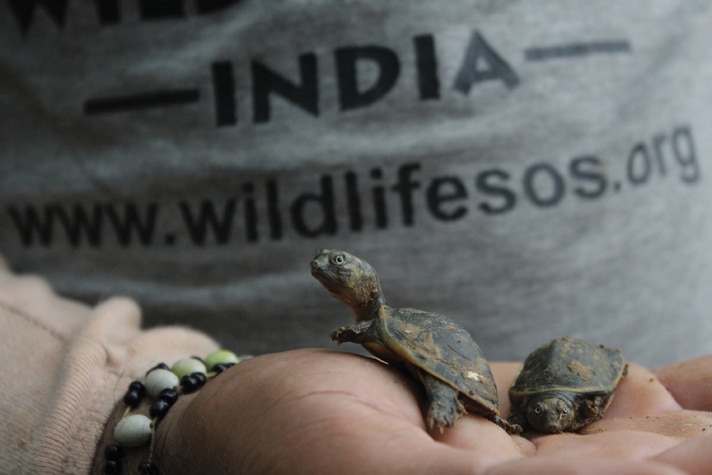In Delhi, India, Wildlife SOS is saving reptiles through rescue and education.
It’s a quiet night at Wildlife SOS (WSOS) headquarters in Delhi, India, until about 11 p.m., when the wildlife-rescue hotline goes off. It’s a panicked metro rail employee dealing with a 4-foot cobra at the Yamuna metro station. After getting more details, the rescue team jumps on their motorbikes and speed off into the darkness. They know time is of the essence; public safety and the snake itself are both in jeopardy.
Calls like this are not unusual for the WSOS Wildlife/Reptile Rescue Hotline offices, which operate in two large metropolitan areas, Delhi and Agra, 24 hours a day. But that doesn’t mean there’s a predictable protocol for responding to these calls. Every case is different, and every situation potentially lethal.
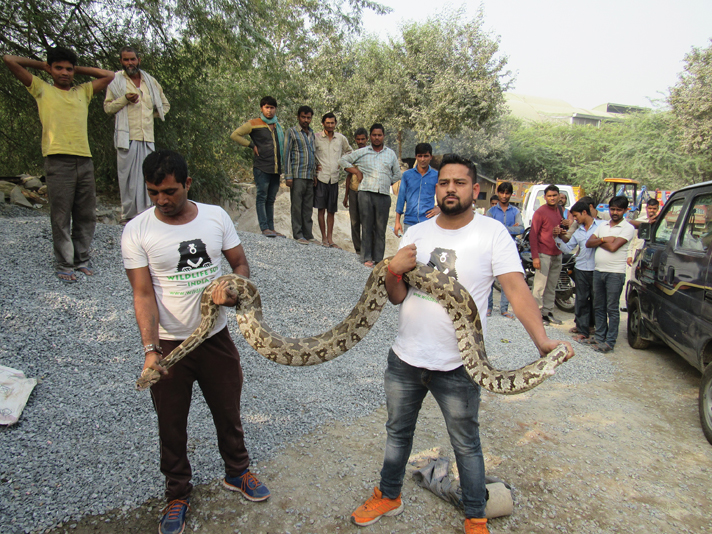
WSOS
Wildlife SOS workers attract a crowd as they remove a large Indian python from a construction site.
The first order of business for the rescue team is to determine the cobra’s location at the station, and then scrutinize the area for any possible escape routes or hiding places. Then the already agitated snake must be carefully approached without making it feel cornered and react. The team is deeply experienced, but there really is no “employee handbook” on removing agitated cobras from public places; each situation presents different challenges and different risks. And every rescue must be conducted with three paramount things in mind: public safety, team safety and snake safety. It can be complicated and dangerous work, but as WSOS cofounder Kartick Satyanarayan says, “Someone has to do it.”
Happily, this rescue goes off without a hitch. The cobra is captured without incident, and no bystanders are injured — beyond a temporary increase in blood pressure, anyway. Later, back at WSOS headquarters, the Indian cobra (Naja naja) is found to be in good health and can be released back to its natural habitat, far from popular metro stations, panicked people and the endless chaos of an urban swirl like Delhi.
Battling Ignorance of Snakes in India
Delhi is India’s capital territory, located in the northern part of the country. It incorporates an area of 573 square miles (significantly larger than New York City) and has a population of nearly 20 million people. It’s certainly not the type of place one would consider a wildlife hotspot; however, within this massive metropolis, snakes, lizards and even turtles are not only present, they actually thrive in some areas. As a result, human-reptile conflicts are simply unavoidable. And though WSOS, which was formed by Satyanarayan and Geeta Seshamani in 1995, is best known for their work with elephants, bears and leopards, the 24-hour reptile-rescue program has been a mainstay of the organization almost since its inception.
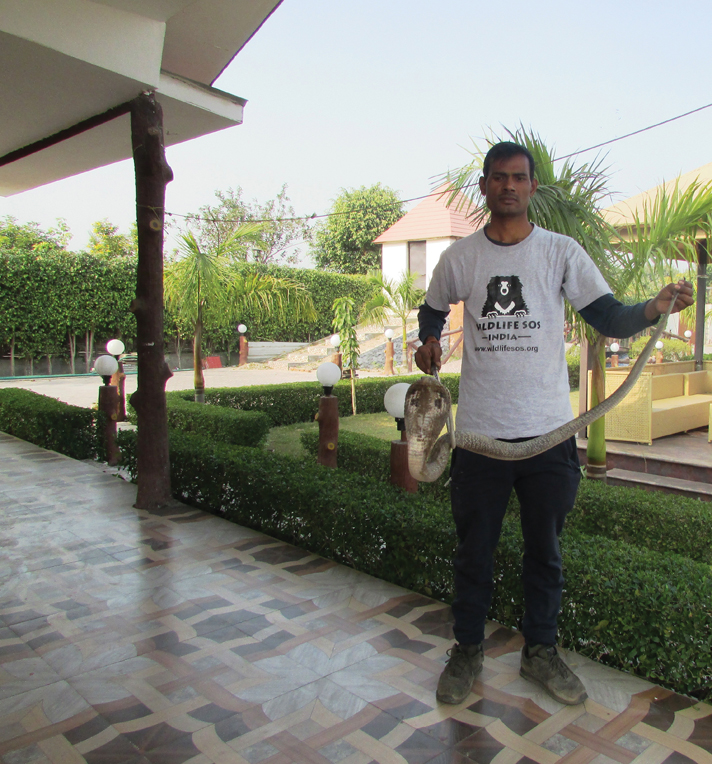
wildlife sos
In Delhi, the Indian cobra (Naja naja) is the most common venomous snake that is rescued by WSOS.
“I started the 24-hour reptile rescue effort in 1995, when I saw that human ignorance was causing the death of thousands of reptiles,” said Satyanarayan. “There was no system in place to educate or help people deal with snakes, and as a result people were getting bitten and snakes were getting killed.
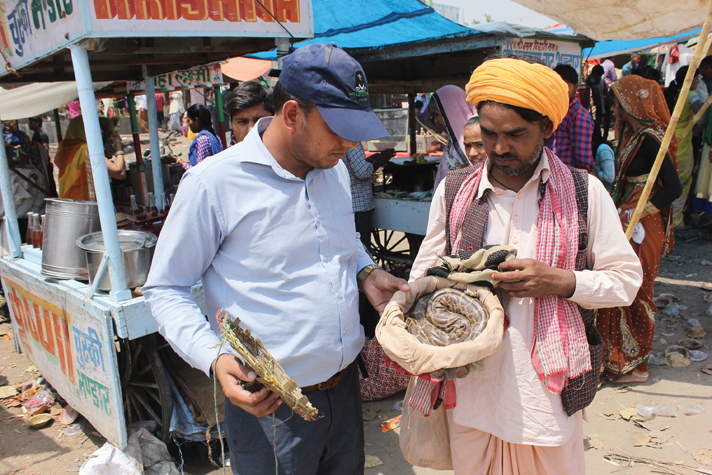
wsos
A snake charmer surrenders an Indian python (Python molurus) to a WSOS team member.
“Every snake sighted was bludgeoned to death, and often by the Delhi Police because they had no other way to address the situation. I volunteered to drive the night ambulance to rescue snakes because I could not stand by and watch hundreds of snakes killed because people misunderstood them.”
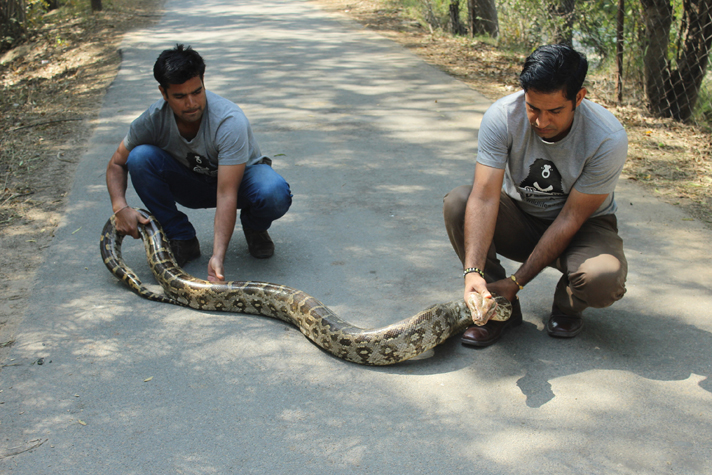
wsos
Wildlife SOS launched in 1995 because the cofounder, Kartick Satyanarayan, was tired of seeing snakes being needlessly killed.
Sometimes public support is difficult to come by. Obviously, snakes aren’t considered the most charismatic of species in most cultures, and rescuing them in a country like India, where many people die from snakebites every year, poses even deeper challenges. But India’s relationship with cobras, and snakes in general, is complex. Although these snakes are certainly feared, they are also revered in mythology and lore, something absent in the West. As well, India’s strong wildlife protection laws cover most snakes, including the common cobra.
Wildlife SOS Rescue Rundown
As the word has gotten out in recent years, the 24-hour rescue program has been seeing a lot more action. In the past six years, WSOS has rescued 2,048 reptiles (not to mention countless birds and mammals) in the Delhi area alone. That’s nearly one reptile a day!
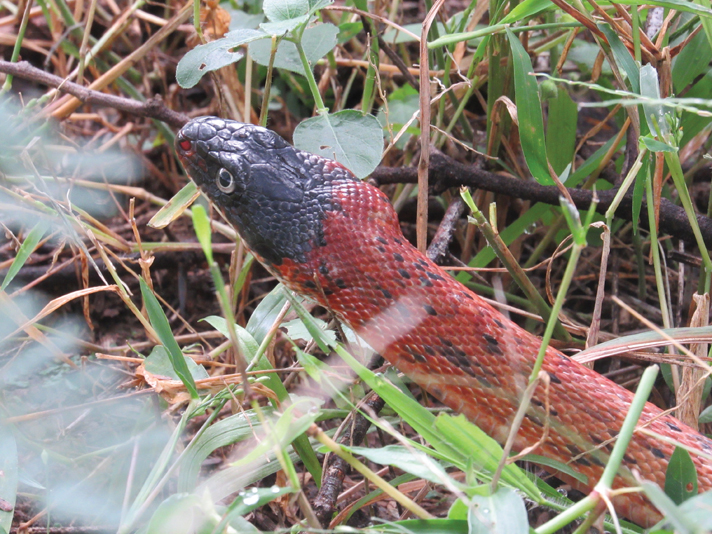
wsos
The royal or diadem snake (Spalerosophis diadema) is an attractive colubrid that is often rescued by WSOS. This one has just been released back into the wild.
The number includes 64 turtles of various species, including the spotted black turtle (Geoclemys hamiltonii), Indian softshell turtle (Nilssonia gangetica), Indian flapshell turtle (Lissemys punctata) and Indian tent turtle (Pangshura tentoria). It also includes 122 monitor lizards, mostly Bengal monitors (Varanus bengalensis), with a smattering of yellow monitors (V. flavescens). The remaining 1,864 rescued reptiles were snakes, and of these, three species were venomous, and one of them — the Indian cobra (Naja naja) — was, and remains, our most “popular” call, with 518 rescues logged.
What these numbers indicate is more than 25 percent of the rescued snakes in Delhi have been cobras over the past six years. But cobras are not the only venomous snakes inhabiting the metropolitan area. The common krait (Bungarus caeruleus), whose venom is more dangerous than that of a cobra (though bites are rare), is also a resident of the metropolitan area. During the past six years, a total of 56 common kraits have been rescued. So, between cobras and kraits, more than 30 percent of the snakes rescued have been venomous. Vipers, specifically the Indian saw-scaled viper (Echis carinatus) and Russell’s viper (Daboia russelii), have also been rescued on rare occasions in the Delhi area.
Non-venomous snakes — colubrids, boas and pythons — still make up the majority of WSOS snake rescues in the Delhi area. The wolf snake (Lycodon capucinus) and the Indian rat snake (Ptyas mucosa) are two of the most commonly rescued species, as well as the aptly named royal or diadem snake (Spalerosophis diadema). Perhaps surprisingly, Russell’s boa (Gongylophis conicus) is also a very commonly rescued snake, while the rock python (Python molurus) is also rescued frequently though not quite as often. The red sand boa (Eryx johnii) is also rescued somewhat regularly in this region of India. Because this enigmatic species has a double-headed general appearance, it is the focus of superstitious beliefs, including that it can cure diseases. Unfortunately, because of this, the red sand boa is often targeted by poachers.
As the numbers show, the reptile rescue center is a generally busy place, but the monsoon rains result in its busiest time of the year, when the rising water table pushes reptiles into more direct conflict with humans. This is also when WSOS sees some particularly rare species, such as the Indian gamma snake (Boiga trigonata), bronzeback tree snake (Dendrelaphis tristis), glossy bellied racer (Coluber ventromaculatus) and the banded kukri snake (Oligodon arnensis).
Reformed Snake Charmers of India
Members of the WSOS rescue team come from markedly different backgrounds, but all are experts in handling and collecting snakes. Some received formal training in a university environment, while others gained their handling experience as snake charmers on the streets of Delhi.
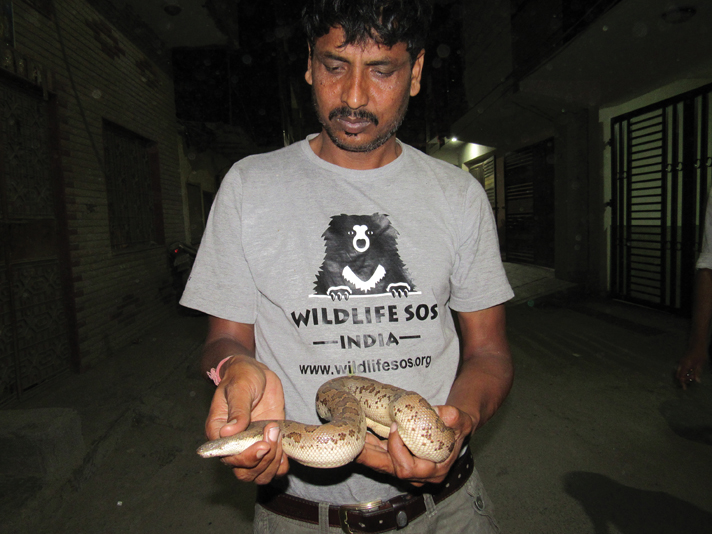
wsos
A Wildlife SOS rescue worker with an Indian sand boa (Eryx johnii) that was rescued from a residential complex.
The latter may seem odd given that snake charming generally involves extremely inhumane treatment of the reptiles involved. But WSOS recognized that snake charming is an ancient practice in India, traditional in some families, and one way of keeping people from doing it would be to provide them with an alternate way to make a living. Some snake charmers displayed incredible expertise and genuinely welcomed the opportunity to help the snakes instead of simply profiting from their suffering, and WSOS offered these individuals jobs with steady salaries. The result has been a success for all: WSOS, the former snake charmers and the snakes themselves.
“Over 50 percent of the rescue team members are reformed snake charmers who I personally convinced to give up the illegal practice of snake charming and work with Wildlife SOS to rescue snakes instead of harming them,” said Satyanarayan. “I gave them an offer they could not refuse: a sustainable and rewarding job that gave them paid leave and medical benefits, an opportunity to hold their heads up high with dignity instead of begging on the streets with a snake in a basket, a chance to be a part of society and to help people using their snake-handling and identification skills to benefit people and snakes.
“I didn’t know if they would make good employees,” Satyanarayan continued. “I just had a gut feeling that these disadvantaged people would accept an alternative career to transform their lives for a better future for themselves and for their families. It was an experiment, and it worked like a charm! We successfully reformed numerous snake charmers and their families. Today, over 40 percent of staff across Wildlife SOS are from indigenous and tribal communities and have been reformed.”
Memorable Wildlife SOS Rescues
Snake-handling aside, team members need to be well versed in handling calls from people experiencing various degrees of panic. Even snake advocates can be rattled if they wake up in the morning to find a find a 4-foot cobra coiled up in the bathroom. Now imagine the average citizen’s response, and you can see how members of the rescue team need to possess some true people skills. Their first order of business is to calm the caller down. Then they will attempt to sensitize the person to the snake’s plight, while ensuring them that a rescuer would never allow a snake to be killed in their presence.
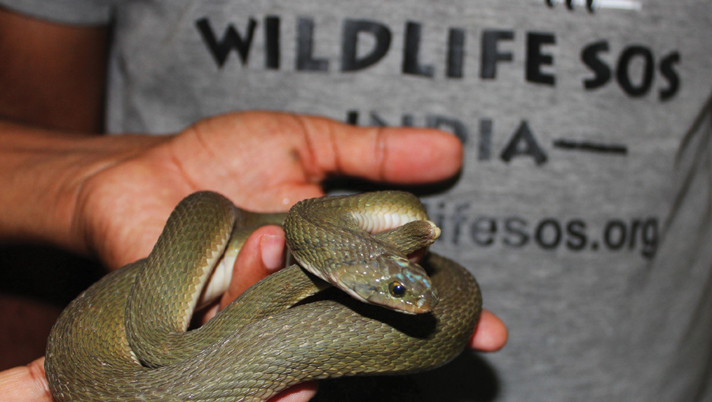
wsos
This is a green keelback snake (Macropisthodon plumbicolor).
Reptile rescues take place all over Delhi, from the most urban spots and grassy soccer fields to military bases and government palaces. One cobra managed to get tangled in the netting of a college soccer field goal and was severely traumatized by the time the rescue team showed up to cut the poor fellow free. Luckily, the snake had only superficial wounds, and it was eventually set free far from the field. Another cobra once coiled its way up and through a motorcycle’s engine bay, resulting in a difficult and time-consuming extraction. Although the motorcyclist was a bit shaken, contacting WSOS was probably the best call he ever made.
Still another cobra camped out inside an ATM machine. When the rescue team members arrived, a security guard told them that he’d been aware of the snake’s presence for more than a day, but clearly he wasn’t feeling particularly heroic about approaching the snake — a very good thing for both the guard and the cobra. Then there was the 4½-foot wolf snake that wound its way into the wiring of an electrical box at the Tughlagabad Air Force Station. Talk about a shock — the workers weren’t sure if the snake was venomous and wisely called WSOS. The snake was extracted and returned to the wild — another success story for all involved.
Wildlife SOS Beneficial Goals
In addition to all the rescue work, WSOS also organizes a number of awareness programs and workshops throughout Delhi to sensitize people and impart knowledge about the much-maligned reptiles. People are taught to cope with the shock of confronting a snake in an unlikely place and how to recognize major species, including the venomous ones, without getting too close. They are also taught some primary first aid in case a bite does occur.
The WSOS workshops also provide an excellent opportunity to debunk common myths and false perceptions about snakes. The idea is that people not only leave the workshops with a greater appreciation for snakes, but also with practical tools to deal with unexpected encounters. Both goals help people conquer their irrational fear of these amazing animals and their place in the world.
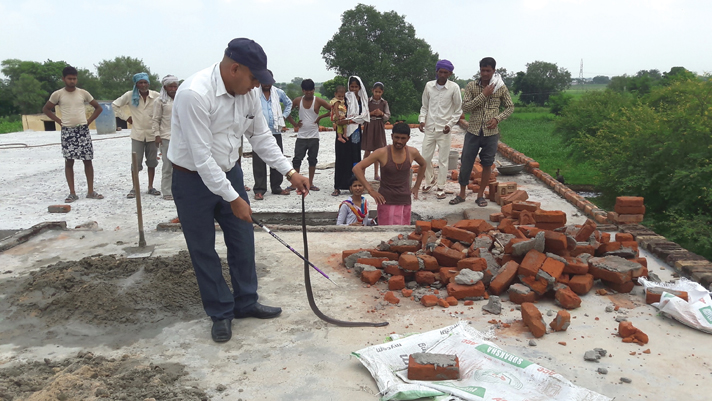
wsos
A cobra being rescued from a construction site.
The outreach programs are making a difference in and around Delhi. In the past, people often killed snakes on sight, but the number of calls coming in to WSOS indicates positive change. People are calling instead of killing. Reptiles, especially snakes, can evoke fear and revulsion in people for whatever reason, but knowledge and awareness regarding the true nature of these creatures will hopefully continue to reduce the violence directed against them.
“I’m glad that the effort we started as an experiment turned out to be a successful social innovation and an intervention to help mitigate human reptile conflict,” Satyanarayan said. “Through our outreach efforts we have been able to debunk negative myths about reptiles, including that harmless rat snakes were venomous and could drink milk from the udder of a cow, monitor lizards could breathe in your direction and give you leprosy, and that red sand boas travel six months of the year using one head and the other six months with the other head, and so on.
“Snakes are magnificent reptiles but hugely misunderstood. We’re just happy that some people are now calling experts instead of trying to deal with the matter themselves. Or worse, killing snakes.”
Thomas Sharp is a wildlife ecologist and a member of the IUCN Sloth Bear Expert Team. He has been working with WSOS for more than 10 years and is currently the Director of Conservation and Research. Most recently he has focused his research efforts on large mammals; however, he began his career working on the brown tree snake project in Guam after studying snakes in graduate school.

